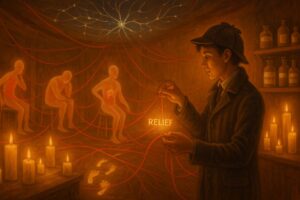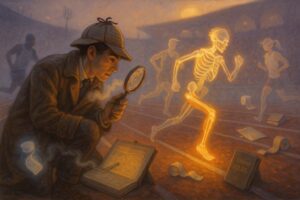
Rehabilitation Medicine
- Posted by admin
- Categories Complex & Integrated Medicine
- Date May 23, 2025
- Comments 0 comment
The Recovery Detective’s Domain - Cracking the Cases of Function, Adaptation, and the Journey Back to Independence
1. Introduction: The Scene of the Specialty
Step into the shoes of a Rehabilitation Medicine sleuth.
This is the specialty of “what now?”—when the acute crisis has passed but the patient’s life has been turned upside down. Rehab physicians (also known as physiatrists) investigate loss of function after stroke, spinal injury, amputation, or chronic disease. They guide recovery not by curing disease, but by restoring possibility. Welcome to a world where healing is measured in milestones, and where the smallest gain—standing, speaking, smiling—can change a life.
2. Key Mysteries They Solve (Common Conditions & Syndromes)
These detectives specialise in solving cases involving:
- Stroke, Brain Injury, and Spinal Cord Injury – navigating neuroplasticity, spasticity, and retraining function.
- Limb Loss and Amputation – optimising prosthetic use and regaining mobility.
- Musculoskeletal Injury and Chronic Pain – managing rehabilitation from orthopaedic trauma or long-term dysfunction.
- Neuromuscular and Degenerative Conditions – such as multiple sclerosis, cerebral palsy, and Parkinson’s.
Each case is not just clinical—it’s personal, layered, and life-defining.
3. Their Trusted Tools & Techniques
Every detective has their kit—and in Rehabilitation Medicine, tools may include:
- Functional Assessments – measuring mobility, cognition, dexterity, and activities of daily living.
- Spasticity Management – with botulinum toxin, oral agents, or physical therapy.
- Assistive Technologies – wheelchairs, orthoses, prosthetics, communication devices.
- Team-Based Plans – co-leading with physiotherapists, occupational therapists, speech pathologists, psychologists, and social workers.
This is collaborative, person-centred medicine—where your prescription might be a strategy, a mindset, or a goal.
4. The Charms of This Field: Why It Captivates the Curious
- Whole-Person Perspective: You treat function, identity, and hope—not just disease.
- Interdisciplinary Spirit: You lead a team that rebuilds lives one step at a time.
- Restorative Joy: Progress can be slow—but incredibly meaningful.
- Long-Term Impact: You form deep relationships and walk with patients through their evolution.
This is medicine that sees beyond the diagnosis—to who the person is becoming next.
5. Challenges: The Toughest Cases They Face
- Slow or Partial Recovery – Improvement may take months—or never fully come.
- System Barriers – Rehabilitation is often under-resourced and undervalued.
- Complex Emotion and Identity Loss – Grief, frustration, and redefinition are part of every case.
- Functional vs Medical Focus – You often battle the perception that “nothing more can be done.”
But the seasoned rehabilitation physician knows: restoring meaning is as vital as restoring movement.
6. Famous Cases and Hallmark Clues
- The “Classic Presentation” – Hemiplegia post-stroke: guiding spasticity management and mobility training.
- The “Zebra” – Weakness with fatigue in a young adult: uncovering functional neurological disorder.
- The “Aha Moment” – A stroke patient’s progress plateaus—until subtle aphasia is addressed through speech therapy.
7. Your Training Trail: How to Join the Investigation
To become a Rehabilitation Medicine detective:
- Train first in general medicine, neurology, or orthopaedics, then sub-specialise in rehabilitation.
- Learn neuroanatomy, musculoskeletal recovery, spasticity treatment, and disability management.
- Master coordination of long-term, team-based care plans.
- Develop deep patience, creativity, and empathy—you’re not just restoring function—you’re guiding transformation.
Whether helping someone walk again, speak again, or dream again, you’re lighting the path forward, one meaningful gain at a time.
8. Final Words: The Signature of the Rehabilitation Medicine Detective
Rehabilitation medicine detectives are stewards of recovery and resilience.
They see the patient behind the impairment—and help that person return to their life, role, and purpose.
They measure success not by labs or scans—but by steps taken, spoons lifted, hugs given, jobs resumed.
So if you’re drawn to healing through adaptation, empowerment, and hope—
then this is your field of quiet triumphs and deeply human victories.



